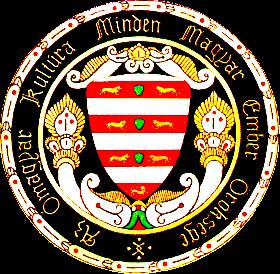Society
of the Friends of Old Hungarian Culture
(ÓMT)

In the 20th year of our existence
|
Society
of the Friends of Old Hungarian Culture |
 |
In the 20th year of our existence |
What is ÓMT? What does it do? What are its objectives?
In a few words
The Society of the Friends of Old Hungarian Culture (abbreviated as ÓMT) is a non-governmental organization of public interest active for the past 20 years, and determined primarily to preserve the heritage of the Middle Ages in addition to popular science programs. The Society's activities are aimed at enriching the present with the experience of the past by preserving and modernising the heritage of the past. Its perspectives reach beyond the national scope, extending to the continent, focusing mainly on Europe. Driven by the aim of solving the problems of the present and preparing for the future the society relies on the experience of the past and people that lived before us, the results of social and natural science researches, as well as foreign skills and methodologies.
The leaders of the Society are professionals, academic historians, economists etc. The president - from the foundation of the society until his death - was Kálmán Benda, a historian professor, and the Society is determined to continue faithfully the work he once began.
The activities of the Society include nearly 200 lectures, numerous social programmes (e.g. a conference titled "Meat softened under the saddle or The hospitality and eating habits of the Hungarian settlers and related peoples of similar equestrian cultures" held together with an exhibition and a rich banquet of meals prepared according to reconstructed ancient Hungarian recipes.)
The ÓMT has
organised the Danube Day Celebration and its side programs since 2003.
saving and distributing (about 100 truckloads of) books to more than 300 schools and libraries including numerous cross-border towns and developing institutions among the Hungarian minorities living in neighbouring countries.
the self-financed establishment of libraries (e.g. Cultural Institution and Public Collection of the "Csángó Hungarians" of Moldva)
publishing books (e.g. the Historical Chronology series; the first Hungarian language history sourcebook by Georg Kraus: The Chronicle of Transylvania 1608-1665; and the publication of the "These Days" and the "Ancient Hungarian Culture" series.)
motion pictures (e.g. Alma Ata is not far from the CIS; The Kipchak Connection; My God, what will happen to us?; On the "Csángó Hungarians" living in Moldva)
education (e.g. working out the curriculum for History of Hungarian Hospitality, Historical Tourism, defining the common alphabet of Hungarian runic writing and its computerised applications and preparing the fonts, publishing the Hungarian Runic Literary Heritage CD).
strengthening the relationship among
municipalities (e.g. very recently the gathering of towns and villages
with "besnyő" and "besenyő" in their names); village development programs for
solving their common problems.
|
Date: 12th January 2006, Budapest |
|
ÓMT Secretary |